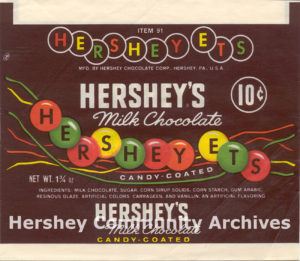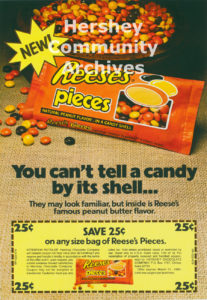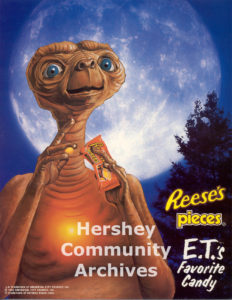Reese’s Pieces: E.T.’s Favorite Candy
How a great candy was saved from oblivion by a small alien visitor from outer space OR the story of Reese’s Pieces, E.T.’s favorite candy.
In the 1950s, Hershey Chocolate developed the capability for panning; that is, sugar-coating a product. M&Ms are probably the best known example of a panned candy product. Hershey’s first panned product was Hershey-Ets, candy-coated chocolate discs or lentils. One marketing challenge for this new product was that when the company introduced Hershey-Ets, people would say, “What is it?” And to define it, you had to use the competitor’s name. That’s a pretty difficult situation. The product was eventually discontinued, except for holiday and seasonal applications.
This was Hershey’s first attempt at a marketing a panned product.
Flash forward a couple decades.
In the 1970s, Hershey Chocolate developed a formula for sweetened peanut meal with the consistency of chocolate. It became the basis for Reese’s Pieces, which were made using the same procedures and equipment as Hershey-Ets.
The new product was originally named PBs. But PBs wasn’t a proper name and the product was soon rechristened Reese’s Pieces.
At that time, Hershey was building a new manufacturing plant in Stuart’s Draft, Virginia, and Hershey planned to manufacture Reese’s Pieces there, in addition to the manufacturing in Hershey.
The product launch was successful. Reese’s Pieces sales went up significantly, held a little bit and then started coming down, not at an alarming rate, but it was certainly a bit disturbing, particularly since the company was in the process of building additional manufacturing capability.
About that time, Hershey Chocolate received a call from Universal Studios, and they said that Steven Spielberg was producing a movie called “E.T.,” and they had decided to use Reese’s Pieces and the candy would play a featured part in the picture. Over the phone, Universal invited Hershey to cooperate by promoting the picture.
Jack Dowd, then Director, New Products Development, traveled to California to meet officials from Universal Studios. The plot was sketched out, and Universal explained that this creature was lured into the house by Reese’s Pieces. The vice president said to Jack that they had decided not to use M&Ms. Trying to come up with an alternative candy, he had asked his son, “What would you use?” And his son said, “Reese’s Pieces.” The vice president said he had never heard of Reese’s Pieces until that moment.
Dowd thought the project looked like something worthwhile. Dowd knew Reese’s Pieces needed some special promotion to save it. He agreed that Hershey Chocolate would support the movie with about a million dollars’ worth of marketing. Hershey would create consumer promotions, trade promotions, and displays, featuring “E.T.” In return, Hershey Chocolate would have an exclusive in the confectionery field for promotion and advertising.
This was the first time Hershey Chocolate had agreed to partner with Hollywood in the promotion of a movie and its use of a Hershey product.
Jack Dowd, in his 1991 oral history interview, remembered:
So I came home and informed Earl Spangler (Hershey Chocolate president) and the staff that we were going to spend a million dollars on a movie that I couldn’t show them the script for, that was going to employ a little green creature from outer space, and I couldn’t show them–at that point it was still confidential–I couldn’t show them a picture of that either. I hadn’t seen it either. I didn’t know what it would look like.
Earl said, “Are you sure this is going to work?”
And I said, “Oh, sure.” Because what else could I say? If I said, “Oh, no,” then we’d have to cancel it and I’d already signed up for it.
We were going to offer a tee-shirt that had a picture of E.T. We wanted a picture, and they sent us a picture of E.T. and the little boy. I proudly showed the picture at the staff meeting, and Earl [Spangler] said, “That is the ugliest creature I have ever seen in my whole life.” There’s no answer to that. You just sit quietly and let the eruption die down.
There was a special screening of the movie in the Hershey Lodge theater shortly after it premiered in New York City. The theater was filled with employees and their families.
At the end, the screen went black and there was total silence. Nobody seemed to want to get off the mountain; they wanted to stay up there. And then there was enormous applause.
So I ran out in the lobby to watch the faces of the people that came by. Many of them were tear-stained. And Earl, who is a very emotional man, came out and his eyes were quite moist, and I said, “Is he still ugly, Earl?”
And Earl said, “Ah, he’s beautiful.” And that was one of the high spots of the whole performance.
The movie was an enormous hit. The publicity was incredible. And the demand was tremendous, and fortunately just at that time the Stuart’s Draft plant came on stream and we were able to meet the demand, and the sales were more, far more than we expected.
Read Jack Dowd’s complete story from our oral history collection.


